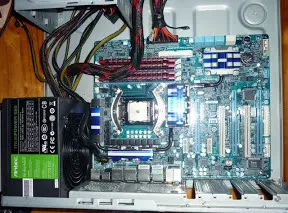Assembling the Hyper-V Server
 Once I figured out my preferred components I emailed MSY and put in an order with MATS. However it turns out that just because MSY have something on their parts list, doesn’t mean they have it in stock. I ended up having to go to their Plympton and City stores, and got the PSU from MATS as MSY didn’t have that at all.
Once I figured out my preferred components I emailed MSY and put in an order with MATS. However it turns out that just because MSY have something on their parts list, doesn’t mean they have it in stock. I ended up having to go to their Plympton and City stores, and got the PSU from MATS as MSY didn’t have that at all.
The case I used was from an old desktop PC. It can accept an ATX board, but as the previous motherboard was a slightly smaller model I had to do some “creative” metal work to move the hard drive bays around so that they could still fit inside the case and not bump into the motherboard.
Things that changed
| --- | --- | | RAM | 2 x G.Skill Ripjaws DDR3-1600 F3-12800CL9D-4GBRL | | Drive (Data) | 2 x Seagate Barracuda 7200.11 SATA 3Gb/s 1.5-TB Hard Drives | | UPS | Eaton Nova 625 AVR |
Noctua CPU Fan vs Ripjaw RAM
 One reason I preferred the G.Skill Ripjaws RAM was that the heat spreaders were less intrusive than those on the “Trident” model. Having said that, once I went to clip the fans onto the Noctua, the wire clips on the RAM-side were in the way of the RAM. A bit of physical effort with a couple of pliers managed to bend the wire clips flatter against the heat sink such that the RAM could just slide past into the sockets on the motherboard.
One reason I preferred the G.Skill Ripjaws RAM was that the heat spreaders were less intrusive than those on the “Trident” model. Having said that, once I went to clip the fans onto the Noctua, the wire clips on the RAM-side were in the way of the RAM. A bit of physical effort with a couple of pliers managed to bend the wire clips flatter against the heat sink such that the RAM could just slide past into the sockets on the motherboard.
Faulty RAM?
 I added an old DVD drive I had lying around and went to install Windows Server 2008 R2. The installation proceeded as expected, then I noticed that the machine had suddenly rebooted. On restarting a message indicating that “Windows had not expected to shutdown” appeared. That’s odd. Allowing it to continue then displayed a message that the installation had failed and to try again.
I added an old DVD drive I had lying around and went to install Windows Server 2008 R2. The installation proceeded as expected, then I noticed that the machine had suddenly rebooted. On restarting a message indicating that “Windows had not expected to shutdown” appeared. That’s odd. Allowing it to continue then displayed a message that the installation had failed and to try again.
Hmm.. Just out of curiosity, I fired up the Memory Diagnostics tool and after ticking over it came up with a message indicating there was a problem! Restarting the machine I went back into the BIOS to see what it said there.. Only 6G of RAM??? Hmm. Now a visual inspection of the sticks of RAM and something looked wrong!
Reseating the RAM in the sockets and re-running the memory diagnostics and everything was happy again.
Enabling AHCI
I realised after I’d installed Windows Server 2008 R2 that I’d left the BIOS at the default settings, which included the SATA emulating IDE instead of AHCI. Because the boot disk was also connected this way, you can’t just change the BIOS and reboot – you need to tweak the registry so that the ACHI driver gets loaded properly.
BSOD
“A clock interrupt was not received on a secondary processor within an allocated time”
Lots of references to this online – some solutions suggest lowering the bus speed slightly. I fiddled around with these a bit but the crashes kept happening. I have no experience over (or under) clocking so I was quite out of my depth. Finally in desperation I changed the BIOS settings to the “fail safe” defaults. This appears to have done the trick.
Cooling
An unfortunate side-effect of trying to re-use an old desktop case is that I don’t think the cooling of the various components is as good as it could be.
Using HWMonitor I am seeing the following temperatures being reported:
| --- | --- | | Component | °C | | CPU Core #0 | 41 | | CPU Core #1 | 36 | | CPU Core #2 | 43 | | CPU Core #3 | 38 | | HDD ST314003 #1 | 53 | | HDD ST314003 #2 | 55 |
I’m thinking getting a proper-size case and possibly some extra cooling might help bring things down to a better level. It would also mean the disks would be slightly more secure in the case!
Networking
I now have a number of machines capable of gigabit networking but my trusty Billion 7402GL modem/router only has 4 100Mb network ports. I purchased a new Asus GX-D1081 8 port gigabit switch to enable better network performance. This also meant I could connect the Windows Media Center PC directly (it was previously using a wireless connection). After confirming the switch worked correctly, I then changed the network settings on all the gigabit-capable machines to enable “Jumbo frames” at 9K. I’m pretty sure this has resulted in a noticeable improvement in performance – especially when browsing pictures through the media center that are stored remotely on the Windows Home Server box.